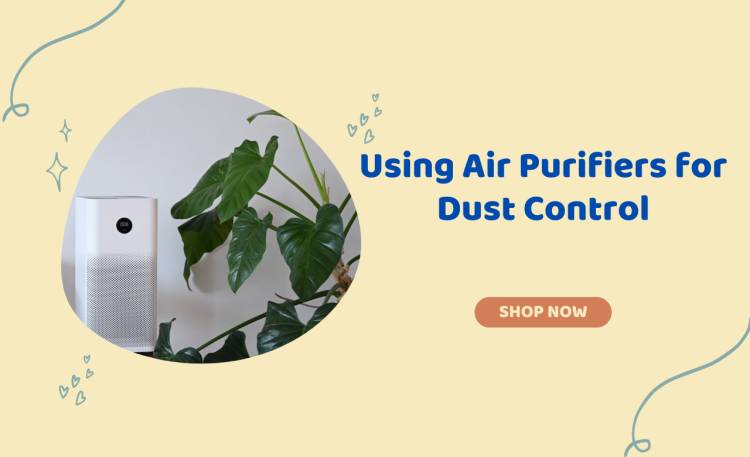
Using Air Purifiers for Dust Control
In today's fast-paced and urbanized world, maintaining a clean and healthy indoor environment has become more important than ever. Dust, a common indoor pollutant, can negatively affect air quality and health. Air purifiers have emerged as an effective solution for controlling dust and improving indoor air quality. In this comprehensive guide, we will explore the benefits of using air purifiers for dust control, how to choose the right one, and tips for maximizing their effectiveness.
Understanding the Problem: Indoor Dust
What is Dust?
Dust is a collection of tiny particles that accumulate in the air and on surfaces. It is composed of a variety of materials, including:
-
Dead Skin Cells: A significant portion of household dust comes from human and pet skin cells.
-
Fabric Fibers: Particles from clothing, carpets, and upholstery contribute to dust.
-
Pollen: Outdoor pollen can enter your home through windows, doors, and on clothing.
-
Pet Dander: Tiny flakes of skin shed by pets are a common component of dust.
-
Soil Particles: Dirt and soil tracked in from outside can add to indoor dust levels.
Health Impacts of Dust
While dust may seem harmless, it can pose several health risks, particularly for individuals with allergies, asthma, or other respiratory conditions. Common health impacts include:
-
Allergic Reactions: Dust mites, a common allergen found in dust, can cause sneezing, runny nose, and itchy eyes.
-
Asthma Attacks: Dust can trigger asthma symptoms and exacerbate existing conditions.
-
Respiratory Issues: Inhalation of dust particles can lead to respiratory irritation and infections.
Benefits of Using an Air Purifier for Dust Control
Air purifiers are designed to remove contaminants from the air, including dust. Here are some of the key benefits of using an air purifier for dust control:
Improved Air Quality
Air purifiers effectively capture and remove dust particles from the air, resulting in cleaner and healthier indoor air quality. This can lead to a noticeable reduction in dust buildup on surfaces and a fresher atmosphere.
Allergy Relief
By reducing the concentration of dust and allergens in the air, air purifiers can help alleviate allergy symptoms. This is particularly beneficial for individuals who suffer from dust mite allergies or other airborne allergens.
Asthma Management
For individuals with asthma, minimizing exposure to dust is crucial. Air purifiers can help prevent asthma attacks and improve overall respiratory health by removing dust particles and other irritants from the air.
Better Sleep
Cleaner air can lead to better sleep quality. Reducing dust and allergens in the bedroom can help prevent nighttime allergy symptoms, allowing for more restful sleep.
Odor Reduction
In addition to dust, air purifiers with activated carbon filters can also remove odors caused by pets, cooking, and other sources, contributing to a more pleasant indoor environment.
How to Choose the Right Air Purifier for Dust Control
HEPA Filters
High-Efficiency Particulate Air (HEPA) filters are the gold standard for dust removal. They are capable of capturing particles as small as 0.3 microns with 99.97% efficiency, making them highly effective at trapping dust.
Tips:
-
Look for air purifiers that explicitly state they use true HEPA filters, not just "HEPA-like" or "HEPA-type" filters.
-
Ensure the purifier has a pre-filter to capture larger particles and extend the life of the HEPA filter.
Room Size and Coverage
Consider the size of the room where you will be using the air purifier. Air purifiers are rated based on their coverage area, typically measured in square feet. Choose a purifier that can effectively cover the entire room.
Tips:
-
Measure the square footage of your room to determine the appropriate size.
-
Opt for a purifier with a slightly larger coverage area than needed for optimal performance.
Air Changes per Hour (ACH)
ACH indicates how many times an air purifier can filter the entire volume of air in a room per hour. For effective dust control, look for an air purifier with a higher ACH rating, ideally 4 to 5 air changes per hour.
Tips:
-
A higher ACH is especially important in rooms with high dust levels or for individuals with allergies or asthma.
-
Consider the CADR (Clean Air Delivery Rate) as well, which measures the purifier’s effectiveness in removing dust, pollen, and smoke.
Noise Levels
Since air purifiers often run continuously, especially in high-dust areas, consider the noise level. A noisy purifier can be disruptive, particularly in bedrooms or offices.
Tips:
-
Check the decibel (dB) ratings of the air purifier at different fan speeds.
-
Look for models with a "sleep" or "quiet" mode designed for low noise operation.
Additional Features
Some air purifiers come with additional features that can enhance their usability and effectiveness. These may include air quality sensors, programmable timers, remote controls, and smart connectivity for control via smartphone apps.
Tips:
-
Air Quality Sensors: Purifiers with sensors can adjust their settings based on real-time air quality.
-
Remote Controls: Useful for adjusting settings without leaving your seat.
-
Smart Features: Models that can be controlled and monitored via apps offer added convenience.
Tips for Maximizing the Effectiveness of Your Air Purifier
Placement
Proper placement of your air purifier is crucial for maximum effectiveness. Place the purifier in a central location where air can circulate freely.
Tips:
-
Avoid placing the purifier against walls or in corners where airflow is restricted.
-
Elevate the purifier if possible, as dust tends to settle on the floor.
Maintenance
Regular maintenance is essential to keep your air purifier working efficiently. This includes cleaning or replacing filters as recommended by the manufacturer.
Tips:
-
Check the filter indicator light if your purifier has one, to know when to replace or clean filters.
-
Clean the pre-filter regularly to remove larger particles and extend the life of the HEPA filter.
Consistent Use
For the best results, run your air purifier continuously, especially in high-dust areas. This helps maintain consistent air quality and prevents dust buildup.
Tips:
-
Use the highest fan speed setting when dust levels are high, such as during cleaning or vacuuming.
-
Reduce the speed or switch to "sleep" mode at night to maintain air quality without disturbing your sleep.
Conclusion
Investing in air purification technology is an effective way to control dust and improve indoor air quality. By understanding the key features to look for and implementing best practices for use and maintenance, you can enjoy a cleaner, healthier, and more comfortable living space. Whether you suffer from allergies, asthma, or simply want to reduce dust in your home, an air purifier is a valuable addition to your indoor environment.











